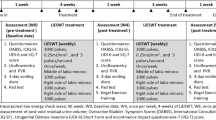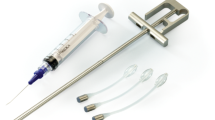Abstract
Purpose
This study is designed to evaluate the long-term efficacy of extracorporeal magnetic innervation (ExMI) in the treatment of women with urinary incontinence.
Methods
Our prospective study included a period of 3 years between May 2005 and October 2008. A total of 137 consequent women with stress and urge incontinence were included in the study. Of the patients, 68 had stress incontinence and others had urge incontinence.
Results
All of the patients with stress incontinence were successfully followed up and 32 (47%) were totally dry in negative stress test at the 6 months after ExMI therapy. In the same group, 27(39%) showed improvement in the frequency of daily leak episodes from 3.2 times to 1.2 times. In the urge incontinence group, all of the patients completed the treatment and they were successfully followed up. While 40 (58%) patients were dry and 18 (26%) significantly improved the average number of incontinence episodes decreased from 3.7 times to 1.7 times per day, treatment failed in the remaining 11 (16%) patients at the 6 months. At 6 months, the recurrence rate was 53%.
Conclusions
At the 6 months after 16 sessions of ExMI had a significant QOL, parallel to decrease in daily pad use and leakage episodes. Only 16 sessions are not effective definitive therapy. The beneficial effects are temporary and there is high recurrence.



Similar content being viewed by others
References
Galloway NT, El-Galley RE, Sand PK, Appell RA, Russell HW, Carlin SJ (2000) Update on extracorporeal magnetic innervation (ExMI) therapy for stress urinary incontinence. Urology 56(6 Suppl 1): 82–86
Barker AT, Jalinous R, Freeston IL (1985) Non-invasive magnetic stimulation of human motor cortex. Lancet 11:1106–1107
Barker AT, Freeston IL, Jalinous R, Jarratt JA (1987) Magnetic stimulation of the human brain and peripheral nervous system: an introduction and the results of an initial clinical evaluation. Neurosurgery 20:100–109
Galloway NT, El-Galley RE, Sand PK, Appell RA, Russell HW, Carlan SJ (1999) Extracorporeal magnetic innervation therapy for stress urinary incontinence. Urology 53:1108–1111
Wagner TH, Patrick DL, Bavendam TG, Martin ML, Buesching DP (1996) Quality of life of persons with urinary incontinence: development of a new measure. Urology 47:67–71
Stach-Lempinen B, Kujansuu E, Laippala P, Metsänoja R (2001) Visual analogue scale, urinary incontinence severity score and 15 D—psychometric testing of three different health-related quality-of-life instruments for urinary incontinent women. Scand J Urol Nephrol 35:476–483
Sand PK, Richardson DA, Staskin DR, Swift SE, Appell RA, Whitmore KE, Ostergard DR (1995) Pelvic floor electrical stimulation in the treatment of genuine stress incontinence: a multicenter, placebo-controlled trial. Am J Obstet Gynecol 173:72–79
Yamanishi T, Yasuda K, Sakakibara R, Hattori T, Ito H, Murakami S (1997) Pelvic floor electrical stimulation in the treatment of stress incontinence: an investigational study and a placebo controlled double-blind trial. J Urol 158:2127–2131
Yamanishi T, Yasuda K, Suda S, Ishikawa N (1999) Effect of functional continuous magnetic stimulation on urethral closure in healthy volunteers. Urology 54:652–655
Bø K (1998) Effect of electrical stimulation on stress and urge urinary incontinence. Clinical outcome and practical recommendations based on randomized controlled trials. Acta Obstet Gynecol Scand Suppl 168:3–11. Review
Fall M (1998) Advantages and pitfalls of functional electrical stimulation. Acta Obstet Gynecol Scand Suppl 168:16–21
Fujishiro T, Takahashi S, Enomoto H, Ugawa Y, Ueno S, Kitamura T (2002) Magnetic stimulation of the sacral roots for the treatment of urinary frequency and urge incontinence: an investigational study and placebo controlled trial. J Urol 168:1036–1039
Yamanishi T, Yasuda K, Suda S, Ishikawa N, Sakakibara R, Hattori T (2000) Effect of functional continuous magnetic stimulation for urinary incontinence. J Urol 163:456–459
Yokoyama T, Fujita O, Nishiguchi J, Nozaki K, Nose H, Inoue M, Ozawa H, Kumon H (2004) Extracorporeal magnetic innervation treatment for urinary incontinence. Int J Urol 11:602–606
Hoşcan MB, Dilmen C, Perk H, Soyupek S, Armağan A, Tükel O, Ekinci M (2008) Extracorporeal magnetic innervation for the treatment of stress urinary incontinence: results of two-year follow-up. Urol Int 81:167–172
Almeida FG, Bruschini H, Srougi M (2004) Urodynamic and clinical evaluation of 91 female patients with urinary incontinence treated with perineal magnetic stimulation: 1-year followup. J Urol 171:1571–1575
Conflict of interest statement
None.
Author information
Authors and Affiliations
Corresponding author
Rights and permissions
About this article
Cite this article
Doğanay, M., Kilic, S. & Yilmaz, N. Long-term effects of extracorporeal magnetic innervations in the treatment of women with urinary incontinence: results of 3-year follow-up. Arch Gynecol Obstet 282, 49–53 (2010). https://doi.org/10.1007/s00404-009-1243-5
Received:
Accepted:
Published:
Issue Date:
DOI: https://doi.org/10.1007/s00404-009-1243-5




